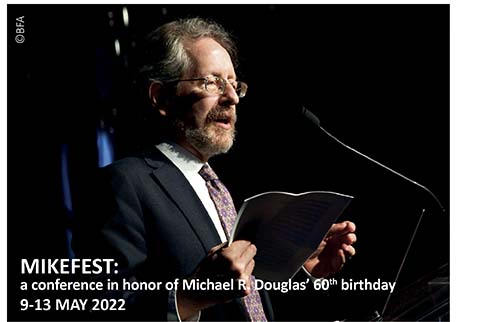Mikefest: A conference in honor of Michael Douglas' 60th birthday
Centre de conférences Marilyn et James Simons
Le Bois-Marie
Organized by Costas Bachas (LPENS), Semyon Klevtsov (Univ. Strasbourg), Nikita Nekrasov (Simons Center for Geometry and Physics & Stony Brook) and Emmanuel Ullmo (IHES), the "MikeFest: a conference in honor of Michael Douglas" will take place from May 9 to 13, 2022.
Registration until: May 3, 2022.
 We are organizing a conference at the IHES on the occasion of Michael R. Douglas' 60th birthday.
We are organizing a conference at the IHES on the occasion of Michael R. Douglas' 60th birthday.
Mike has a long association with IHES, as a visiting professor in 2000-2008 (Louis Michel Chair), by leading the US-based fundraising effort, and as a president and chairman of the Friends of IHES in 2013-2021.
The conference will cover the topics on which Mike has worked and made profound contributions: string theory, matrix models, physical mathematics, and machine learning.
Covid-19 regulations: seats in the conference center are limited to 70 people. The conference will also be available via Zoom.
Invited speakers:
- Vijay Balasubramanian, Univ. of Pennsylvania
- Alexander Belavin, Independent Univ. Moscow (TBC)
- Ilka Brunner, Univ. München
- Alain Connes, IHES & Collège de France
- Frederik Denef, Columbia Univ.
- Bartomeu Fiol, Univ. de Barcelona
- Jaume Gomis, Perimeter Institute (TBC)
- Sasha Gorsky, IITP RAS, MIPT
- Chris Hull, Imperial College
- Shamit Kachru, Stanford Univ.
- Volodya Kazakov, LPENS
- Maxim Kontsevich, IHES
- Patrick Massot, LMO - Univ. Paris-Saclay
- Luca Mazzucato*, Univ. of Oregon
- David McAllester, Toyota Tech. Inst. Chicago (TTIC)*
- Liam McAllister, Cornell Univ.
- Greg Moore*, Rutgers Univ.
- Rémi Monasson, LPENS
- Eliezer Rabinovici, Hebrew Univ. of Jerusalem
- John Schwarz, CALTECH
- Nathan Seiberg*, IAS
- Steve Shenker*, Stanford Univ.
- Eva Silverstein*, Stanford Univ.
- Christian Szegedy, Google Research
- Washington Taylor*, MIT
- Alessandro Tomasiello, Univ. Degli Studi Di Milano Bicocca
- Josef Urban, CIIRC
- Steve Zelditch*, Northwestern Univ.
* remote talks
